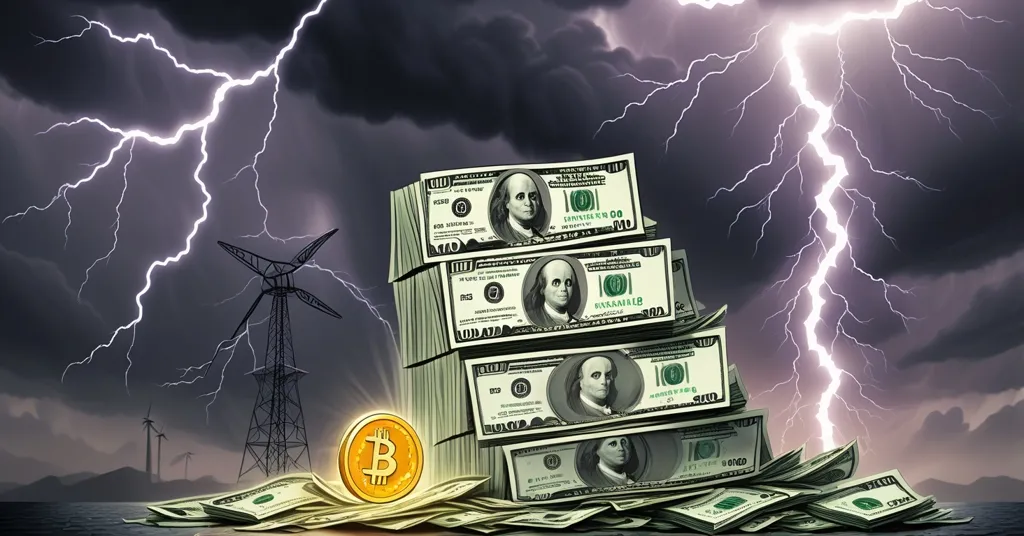Trump’s “Big Beautiful Bill” Passes Senate: Bitcoin and Crypto Face Debt Shockwaves

Trump’s “Big Beautiful Bill” Passes Senate: Bitcoin and Crypto Brace for Impact
On July 1, 2025, the U.S. Senate narrowly pushed through President Donald Trump’s “Big Beautiful Bill” with a razor-thin 51-50 vote, cinched by Vice President JD Vance’s tie-breaking nod. This sprawling piece of legislation, brimming with tax cuts, debt hikes, and policy overhauls, doesn’t mention Bitcoin or cryptocurrency—but its shockwaves could jolt the crypto space like a lightning strike on a hardware wallet.
- Narrow Victory: Senate passes bill 51-50 with Vance’s tie-breaker; three Republicans dissent.
- Bill Highlights: Extends 2017 tax cuts, raises debt ceiling by $5 trillion, funds border security and defense.
- Crypto Stakes: Debt surge and energy shifts could sway Bitcoin adoption and mining economics.
Breaking Down the “Big Beautiful Bill”
This legislative titan embodies Trump’s hallmark priorities, packing a punch across multiple sectors. It extends the 2017 tax cuts, preventing rate hikes that were set to kick in by the end of 2025—a move impacting millions of American taxpayers. The bill also throws massive funding at national priorities: $175 billion for border security, $150 billion for defense, and a $50 billion fund for rural hospitals starting in 2026, a sweetener that failed to win over dissenters like Senators Rand Paul of Kentucky, Susan Collins of Maine, and Thom Tillis of North Carolina. A temporary hike in the state and local tax deduction cap to $40,000 for five years aims to ease regional gripes, but the fiscal cost is staggering. The debt ceiling jumps by $5 trillion, and the Congressional Budget Office projects a $3.3 trillion addition to the national debt over the next decade. The White House, predictably, spins a different tale, tweeting that it’ll somehow cut the deficit by $5 trillion through vague “growth measures.” Senate Majority Leader John Thune framed it as a historic win, declaring:
“With this legislation, we’re fulfilling the mandate we were entrusted with last November and setting our country and the American people up to be safer, stronger, and more prosperous.”
The White House echoed the triumph on social media with characteristic flair: “MAGA VICTORY: The United States Senate PASSES President Trump’s One Big Beautiful Bill 🇺🇸🦅🎉.” But the celebration masks some brutal trade-offs. Changes to Medicaid, including new work requirements and slashing provider taxes from 6% to 3.5%, could strip health insurance from 12 million Americans over ten years, according to CBO estimates. On a different note, the bill dips into tech and energy policy—removing taxes on solar and wind projects but with strict tax credit rules (projects must start construction within one year of enactment or be operational by 2027 as detailed in Senate energy legislation), and lifting a 10-year moratorium on state-level AI regulation with a near-unanimous 99-1 vote, Tillis standing alone in opposition. House Speaker Mike Johnson now faces a sprint to ram this through the House by Trump’s symbolic Independence Day deadline of July 4, 2025. For more on the Senate vote, including key opposition from figures like Rand Paul, check the detailed Senate vote breakdown.
Debt Surge: A Bull Case for Bitcoin Adoption?
Let’s cut to the chase: how does a $3.3 trillion debt spike rattle the crypto world? For starters, it’s a glaring warning sign for fiat currency stability. Bitcoin, often hailed as “digital gold,” thrives in moments of fiscal chaos—think of it as a lifeboat when the dollar starts taking on water. Fiat devaluation, where traditional currency loses purchasing power due to inflation or excessive money printing, has historically pushed investors toward decentralized assets. Look at past U.S. debt ceiling crises: in 2011, Bitcoin’s price climbed from around $7,000 to $10,000 amid economic jitters, and a similar pattern emerged in 2023. With a fixed supply of 21 million coins, Bitcoin—built on a blockchain, a tamper-proof ledger without banks or governments—stands immune to the kind of reckless spending this bill represents. If the dollar stumbles under this new debt load, more people might see Bitcoin as a hedge against inflation. Community discussions on platforms like Reddit explore this potential boost for Bitcoin adoption. Could this be the ultimate unintended ad campaign for crypto adoption?
But let’s not get carried away with maximalist fever dreams. A counterpoint looms: if debt-fueled uncertainty spikes, so could Bitcoin’s volatility. Sharp price swings might scare off newcomers, and governments spooked by fiat outflows could slap on harsher regulations, seeing crypto as a threat to monetary control. Insights on how national debt influences Bitcoin’s value highlight these complex dynamics. While the Bitcoin faithful might cheer centralized mismanagement as proof of concept, mass adoption under duress isn’t a guaranteed smooth ride.
Energy Policy: A Mixed Bag for Bitcoin Mining
Could Trump’s energy tweaks make Bitcoin mining a tougher grind? Mining, for the uninitiated, is the backbone of Bitcoin’s network—miners use powerful computers to solve complex puzzles, validating transactions and securing the blockchain, all while guzzling electricity like a Hummer on a joyride. With Bitcoin’s energy use estimated at 0.1% of global electricity, many miners have pivoted to renewables like solar and wind to slash costs and fend off environmental critics. The bill’s removal of taxes on these projects sounds like a godsend, but there’s a snag: tax credit eligibility is tight, with deadlines that could discourage long-term energy development. Projects must break ground within a year or be live by 2027, a timeline that might leave developers—and by extension, miners—high and dry. For deeper analysis on Bitcoin mining energy policy challenges in 2025, the outlook remains uncertain.
Industry voices aren’t exactly singing praises. Harry Godfrey from Advanced Energy United noted that while last-minute Senate tweaks dodged “cataclysmic impacts” like soaring electricity rates, the bill still “harms clean energy development.” Abigail Ross Hopper of the Solar Energy Industries Association was blunter, slamming it for undermining U.S. energy leadership. For miners, especially in regions like Texas where cheap wind power has been a lifeline, this uncertainty could mean higher operational costs or delayed access to green energy. Picture a small-scale miner praying for a sunny day while policy gridlock dims the forecast. Will this “big beautiful” energy plan make mining uglier, or is it a minor hiccup in the long march to sustainable crypto?
AI Regulation: A Warning Shot for Crypto Oversight?
The bill’s near-unanimous decision to lift a 10-year moratorium on state-level AI regulation might seem like a side note, but it raises eyebrows for decentralization advocates. If states can now meddle in AI, could crypto be next on the chopping block? Trump’s track record on cryptocurrency is a rollercoaster—dismissing Bitcoin as a “scam” in 2019, then peddling NFTs a few years later. This flip-flopping, paired with the bill’s precedent for fragmented tech oversight, hints at regulatory volatility ahead. Elon Musk, a tech heavyweight with a history of hyping Bitcoin and Dogecoin, has already blasted the bill as fiscal hypocrisy, even threatening political retaliation. When Musk speaks, crypto markets perk up—his dissent adds fuel to fears of centralized overreach.
On the flip side, state-level rules could foster innovation if they’re light-touch, much like how varied state laws on cannabis spurred experimentation before federal shifts. But for Bitcoin purists, any whiff of regulatory patchwork is a betrayal of the decentralized ethos. The question lingers: are we seeing the blueprint for a future where crypto faces a maze of inconsistent state laws? For a broader look at the legislation itself, refer to the detailed overview of the Big Beautiful Bill.
Broader Impacts: Fueling the Decentralization Narrative
Zooming out, the bill’s societal fallout can’t be ignored. The projected loss of health insurance for 12 million Americans under Medicaid cuts isn’t just a cold statistic—it’s a gut punch that could erode trust in centralized systems. When governments fumble basic welfare, the allure of self-sovereign tools like crypto wallets grows. Decentralization isn’t just tech jargon; it’s a response to institutional failure. If public discontent festers, more folks might turn to Bitcoin or decentralized finance (DeFi) platforms for financial autonomy, bypassing broken systems altogether. Market trends discussed in debt surge and crypto investment shifts suggest institutional interest may follow.
Yet, let’s play devil’s advocate: economic growth, if the White House’s rosy predictions hold (and that’s a big if), could pour capital into altcoins and DeFi projects on networks like Ethereum. These platforms often tackle niches Bitcoin sidesteps—think smart contracts, which are self-executing agreements coded to run automatically, powering everything from decentralized lending on Uniswap to tokenized real estate. A rising tide of investment might lift all crypto boats, even if Bitcoin remains the flagship store of value. Still, with $3.3 trillion of debt on the line, I’m not betting the farm on magical growth fairy tales.
What’s Next for Crypto?
This bill, for all its centralized pomp, underscores a raw truth: old-school politics still casts a long shadow over decentralized tech. Whether it’s nudging investors toward Bitcoin as a safe haven during a debt crisis, reshaping the energy economics of mining, or hinting at regulatory battles to come, the implications are real. As the House vote looms by July 4, 2025, the crypto community should stay sharp—not for what’s explicitly in the legislation, but for the dominoes it might topple. Will fiscal blunders like this cement Bitcoin’s case as the future of money, or just toss another wrench into the gears of adoption? For initial coverage of the Senate’s decision, see the Senate passing Trump’s landmark bill on July 1.
Key Questions and Takeaways for Crypto Enthusiasts
- How could a $3.3 trillion debt increase boost Bitcoin adoption?
It may erode confidence in fiat currency, pushing investors to Bitcoin as a hedge against inflation and devaluation, much like price surges seen during past U.S. fiscal crises in 2011 and 2023. - What are the implications of the energy policy for Bitcoin mining?
Tax removal on solar and wind projects offers cost-saving potential, but tight tax credit deadlines could delay access to cheap, green energy, hiking costs for miners reliant on renewables. - Could the AI regulation shift signal future crypto oversight risks?
Yes, state-level AI rules might preview fragmented crypto regulations, posing a challenge to decentralization if inconsistent or restrictive policies emerge under this administration’s precedent. - Why should crypto users care about a bill without direct crypto provisions?
Macroeconomic moves like debt hikes and energy reforms indirectly shape Bitcoin’s appeal as a safe haven and the practical realities of mining, showing centralized policies still impact decentralized tech. - How might altcoins and DeFi benefit from this fiscal policy?
If promised economic growth materializes, fresh capital could flow into Ethereum-based DeFi platforms and altcoins, driving innovation in areas like smart contracts that Bitcoin doesn’t prioritize.



